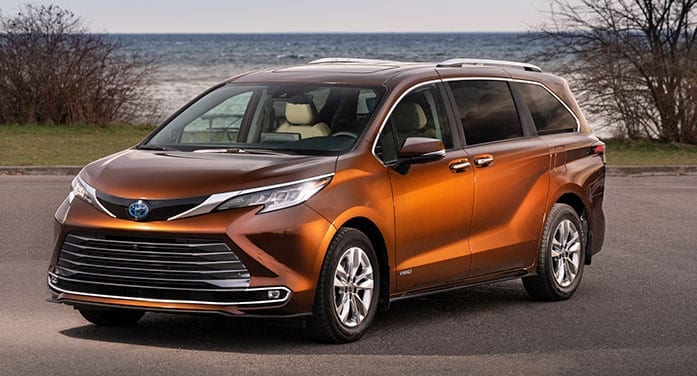 While SUVs of all shapes and sizes have exploded in popularity, the equally usable minivan has quietly languished.
While SUVs of all shapes and sizes have exploded in popularity, the equally usable minivan has quietly languished.
General Motors and Ford don’t make minivans anymore, and while some other manufacturers have taken up the slack, they don’t sell in huge numbers.
That’s kind of a shame because, for most applications, a minivan can do everything an SUV can, and that includes all-wheel-drive and hybrid configurations.
The Toyota Sienna is a case in point. Yes, it’s kind of an uncool grocery-getter, but it has all-wheel drive and, now, a hybrid drivetrain.
Introduced to the market in 1997, the Sienna now comes in eight variations, in front-wheel or all-wheel drive. And they’re all powered by Toyota’s Hybrid Synergy Drive powertrain. As of 2021, the Sienna is hybrid only.
That means a 2.5-litre four-cylinder engine mated to an electric motor and a continuously variable transmission (CVT), with a power output of 245 horsepower and a combined fuel rating of 6.5 litres/100 km for the front-wheel-drive version. My test model – the top-end Limited – can be had with front-wheel or all-wheel drive. The latter is slightly thirstier at 6.7 litres/100 km.
Whichever you choose (there’s a $2,000 price difference), you’re getting a luxury minivan that’s comfortable, full of modern conveniences and roomy.
How roomy?
With all the seats folded down or taken out, Toyota says there’s 2,860 litres (110 cubic feet) of storage. The Honda Odyssey has slightly more, while the Chrysler Pacifica has significantly less. So not the roomiest but almost. Curiously, the front-wheel-drive version can accommodate one more passenger than its all-wheel stablemate (eight versus seven).
Some things I liked about the Sienna Limited all-wheel-drive version:
Comfortable, roomy interior, with all kinds of elbow room and places to put things. The Sienna received an interior redesign for 2021, and there are storage nooks and pockets all over the place. Bring on the juice boxes and hockey bags.
A very stable driving experience. Because of its long wheelbase, the Sienna is smooth and almost limousine-ish on the road, Excellent noise, vibration and harshness (NVH) levels, and an overall refined feeling behind the wheel.
Usable driver controls and switchgear. The Sienna doesn’t have the same dash graphic as the Prius, for example; no slick little animation showing you where the power is going or a readout congratulating you on your driving ability. Buttons and knobs are easy to find and user-friendly.
Fuel economy for a vehicle of this size is exemplary, at 6.8 litres/100 km in town and 6.6 on the highway. That’s the best in the minivan segment, far and away.
On the other hand:
This not a lively vehicle – kind of a slug, actually. The Honda Odyssey, in comparison, is a hotrod. I love the fact that you can stay on pure electric power up to about 50 km/h if you drive like a granny. But don’t look for too much in the way of reserve power for overtaking and so on – it just isn’t there.
The centre row seats still need to be manhandled out of the vehicle. The third-row seats fold slickly into the floor, revealing 2,129 litres (75.2 cubic feet) of cargo area, but the Sienna lacks this feature for the centre row, where it’s really needed.
It’s kind of pricey. My Limited model starts at just under $60,000. After taxes and extras, you’re over $70,000. The base LE front-wheel-drive version is just under $40,000 and, if you don’t need all the extras, that would be the way to go. You get everything you really need (plus eight-passenger capacity) for almost half the money.
It’s kind of hard to understand how the SUV has eclipsed the minivan in popularity when, most of the time, they do the same thing. Maybe it’s the coolness factor.
But if I’m in the market for a practical, usable vehicle that covers most of the bases, it’s no contest.
2021 Toyota Sienna
Engine: 2.5-litre four-cylinder/hybrid-drive electric motor
Transmission: continuously variable
Drive: front-wheel and all-wheel
Horsepower: 245
Price range: $39,990 to $58,990
Fuel economy: 6.8 litres/100 km city and 6.6 litres/100 km highway, with regular gas
Some alternatives: Honda Odyssey, Kia Sedona, Dodge Grand Caravan, Chrysler Pacifica
Ted Laturnus writes for Troy Media’s Driver Seat Associate website. An automotive journalist since 1976, he has been named Canadian Automobile Journalist of the Year twice and is past-president of the Automobile Journalists Association of Canada (AJAC). For interview requests, click here.
The views, opinions and positions expressed by columnists and contributors are the authors’ alone. They do not inherently or expressly reflect the views, opinions and/or positions of our publication.




